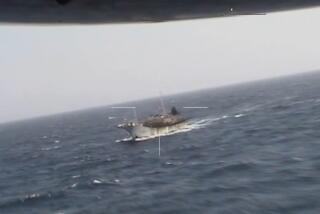Industry Flounders : Fishermen See Profits Sink, Costs Mount
Gary Soderberg peered into the dark tank and estimated: 70 scoops.
It had not been the best of nights for the Pamela Rose, a commercial fishing vessel whose home port is Newport Harbor. On a good night, the tanks aboard the 54-foot vessel might contain 800 scoops of anchovies, sardines or squid, said Soderberg, one of four crewmen on the boat. Each scoop is about equivalent to a bucketful.
Skipper Steve Greyschock dismissed the anemic catch--they would do better tomorrow night, he reckoned. Greyschock had enough anchovies to satisfy the live bait needs of three commercial sport fishing boats, with enough left over to supply sport boats that leave later in the day from Newport Landing and the Balboa Pavilion.
Earning a living from the sea has always been a rugged enterprise, but it has become particularly tough in recent years because of intense foreign competition, the closing of domestic canneries that cannot compete with cheaper overseas facilities and rocketing liability insurance costs, which have become the bane of just about every business.
âWeâre in the same boat as farmers, only worse,â said Bill Perkins, manager of the San Diego-based Western Fishing Boat Owners Assn. Like farmers, fishermen tend to have large investments in equipment and are grappling with sliding commodity prices.
âThe only bright spot is the price of fuel,â said Perkins, referring to the relatively low cost of diesel fuel, which drives the commercial fishing fleet.
The workday for Greyschock and his crew typically begins at midnight when they cast off from the boatâs berth and make their way through the darkness to the open sea.
Sport fishermen typically talk about the âbig oneâ; what Greyschock wants is a lot of little ones. An anchovy is about six inches long, and a school could consist of billions and weigh 20,000 tons.
Many Uses for Anchovies
If he doesnât end up squirming on a sport fishermanâs hook, an anchovy is likely to be roasted and piled atop a pizza, made into cattle or chicken feed, processed into a bag of fertilizer or pressed for his oil to be used in linoleum.
From the open top deck of his boat, Greyschock listens to the ticking return from his sonar while scanning two color video screens that indicate the depth and location of fish in the waters ahead and to the sides of the boat. âA fisherman has to have top gear to be competitive,â he said.
At about 3 a.m., the screen shows a school that appears to be several hundred feet long and 50 feet thick, but Greyschock judges that they are too deep for the boatâs net and passes them by.
From the open upper deck of the boat, he also scans the charcoal water surface for a âfireball,â the luminescence created as a school of fish disturb the phosphorus in the water. Despite the increased reliance on new technology, such visual clues are still important to commercial fishing.
Visual Aids
âYou canât beat the old eyeball,â says Jack Turley of Santa Ana, a retired commercial fisherman.
Often joining in the hunt are aerial spotters, pilots in single-engine aircraft who scan the surface and help direct the boats to the fish.
Periodically, Greyschock switches on a powerful hand strobe light and scans the water for âred eyesâ--fish staring back at the light.
Once a school is found, Greyschock cuts the engine and switches on the boatâs powerful lights, which attract the school to the surface near the boat. Within minutes, the perimeter of the boat is teeming with thousands of tiny excited fish.
Low-Teach Equipment
Next, a crewman is dispatched in a 10-foot skiff equipped with some decidedly low-tech equipment: oars, a car battery and an old desk lamp.
The tricky part of the nightâs work, which may be repeated a dozen times, comes next.
Aboard the skiff, crewman Harvey Farrell hooks the 150-watt lamp to the car battery, turns it on and paddles away from the Pamela Rose, which switches off its lights and idles.
If the fish follow their instincts, they will follow with the skiff light while the Pamela Rose circles the school with its $15,000 lampara net. When the loop is complete, the net is winched onto the boat, shrinking the circle and pushing the fish into a funnel trap.
Rounding Them Up
âTheyâre like cattle,â said Fred Hatfield, another crewman. âWe round âem up.â
But sometimes the fish are unpredictable and tough to round up.
âTheyâre spawning now,â Greyschock said, âand so they are nervous (and) hard to catch. Nature always protects herself.â
A commercial fishing crew is something like an army squad on patrol--hours of tedious searching are interrupted by a burst of feverish activity. Their work is both an ancient art and a modern science, requiring an intricate knowledge of the ocean and sophisticated equipment.
However, the increasing necessity for expensive equipment underscores the troubles facing the industry, problems which have thinned the ranks of commercial boats in recent years.
Plunging Prices
Low prices also have battered the industry.
In the last two years for example, the price of bluefin tuna has dropped from $1,200 a ton to about $650 a ton. Bonita now sells for about $200 a ton; two years ago it was $580 a ton.
Only squid and anchovy have gone up in price. Squid now fetches about $300 a ton, double the $150 a ton about two years ago, and anchovy sells for about $200 a ton, up from $100.
Greater international competition helped create the surpluses that drove prices down, and âit looks like more of the same (for 1986),â said Sam Herrick, an economist with the National Marine Fisheries Service, an office of the U.S. Department of Commerce.
Canners are another casualty of the stiffened competition. There are just two left in Southern California, both of them on Terminal Island, off Long Beach.
Looking for Answers
The depth and speed of the changes in the commercial fishing industry have left many grappling for solutions.
âIf I knew . . . Iâd be somewhere in a three-piece suit,â said Tom Greene, a fish spotter who flies from Torrance Airport. When Greene began spotting a decade ago, there were 35 boats operating out of the San Pedro-Wilmington harbors. Now there are 25.
Insurance costs have accelerated the exodus from commercial fishing.
Greyschock pays $19,000 a year for insurance for his $320,000 boat and has kept a second boat out of service because of the liability costs. Five years ago, his annual insurance bill was $6,000.
Seasonal Uncertainties
Insurance rates are âabsolutely unbelievable,â said Greyschock. â(The insurance costs) will kill commercial fishing in this country.â
The seasonal nature of the industry adds more uncertainty to a commercial fishermenâs life.
Migration, feeding habits and spawning patterns direct the movements of fish, and thus the life of a commercial fisherman in Southern California is driven by the habits of his quarry. Albacore, bonito, bluefin tuna, sardines and swordfish are most plentiful in the summer, anchovies and squid in the fall and mackerel in winter.
In winter, the Pamela Rose typically goes out less frequently than in summer when Greyschock and his crew usually will go out every night. Vacations are taken during full moons, when the fish tend to scatter and do not respond to the Pamela Roseâs lights.
Uneven Income
That means earnings tend to peak in summer and dribble off in winter.
âYou get so darn far in hock in winter, it takes all summer to get out,â said Hatfield, who nevertheless says he has no interest in going back to carpet installation, his previous occupation.
As the only regular night-operating commercial fisherman homeported in Newport Beach, Greyschock, 35, is part of a shrinking fraternity of men in Orange County who make their living from the sea. Greyschock, whose father operated charter sport-fishing boats at Newport Harbor, âfell in love with the oceanâ as a boy and has been fishing commercially for 15 years.
Commercial fishing crewmen are an independent breed. Most crewmen work, save and dream for the day when they will be able to skipper their own boat. Crewmen typically split a third of the catch.
New Difficulties
Greyschock started as a crewman and eventually saved enough to buy his own boat. But that route to success at sea has become significantly tougher.
In addition to low prices, liability woes and intense competition, commercial fishing operators at Newport Harbor face additional economic pressures.
As the harbor has developed into a home for luxury pleasure boats and become the focal point for one of the nationâs most expensive residential and commercial areas, commercial fishing has gradually moved out of the harbor.
Itâs a trend that seems likely to continue.
With its high slip rents and lack of facilities for commercial fishermen, further tightening of the commercial fishing industry seems inevitable.
More to Read
Inside the business of entertainment
The Wide Shot brings you news, analysis and insights on everything from streaming wars to production â and what it all means for the future.
You may occasionally receive promotional content from the Los Angeles Times.







